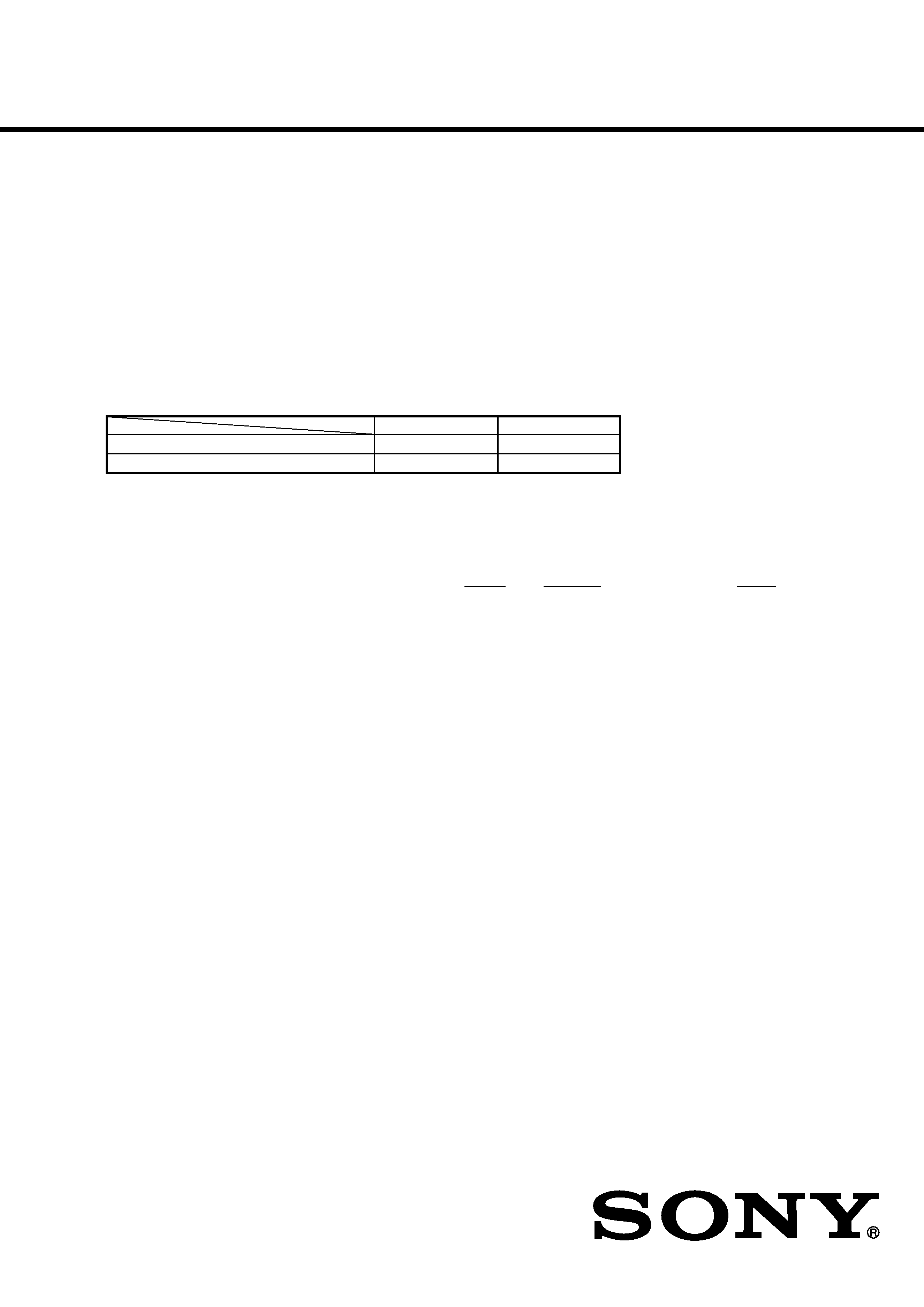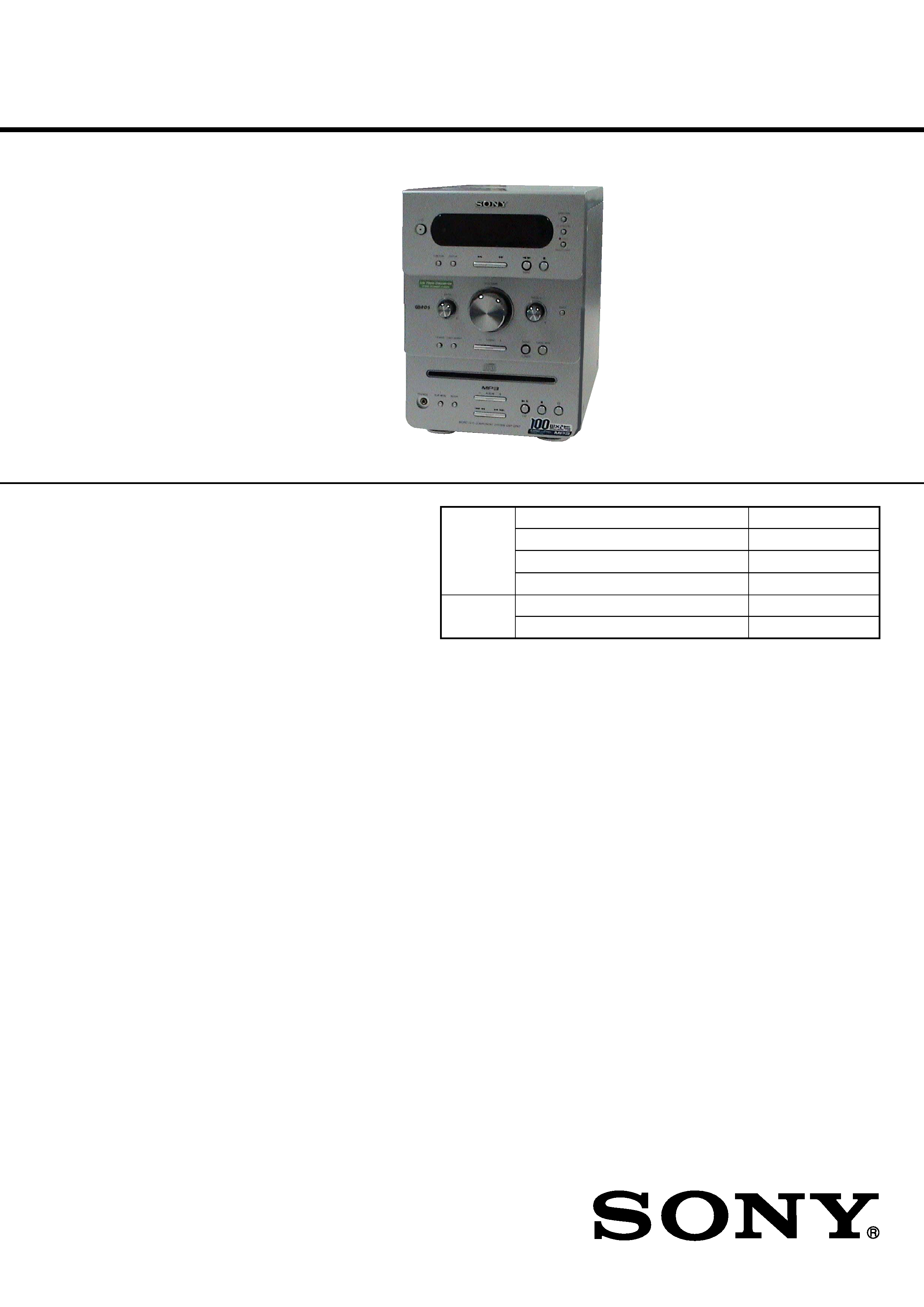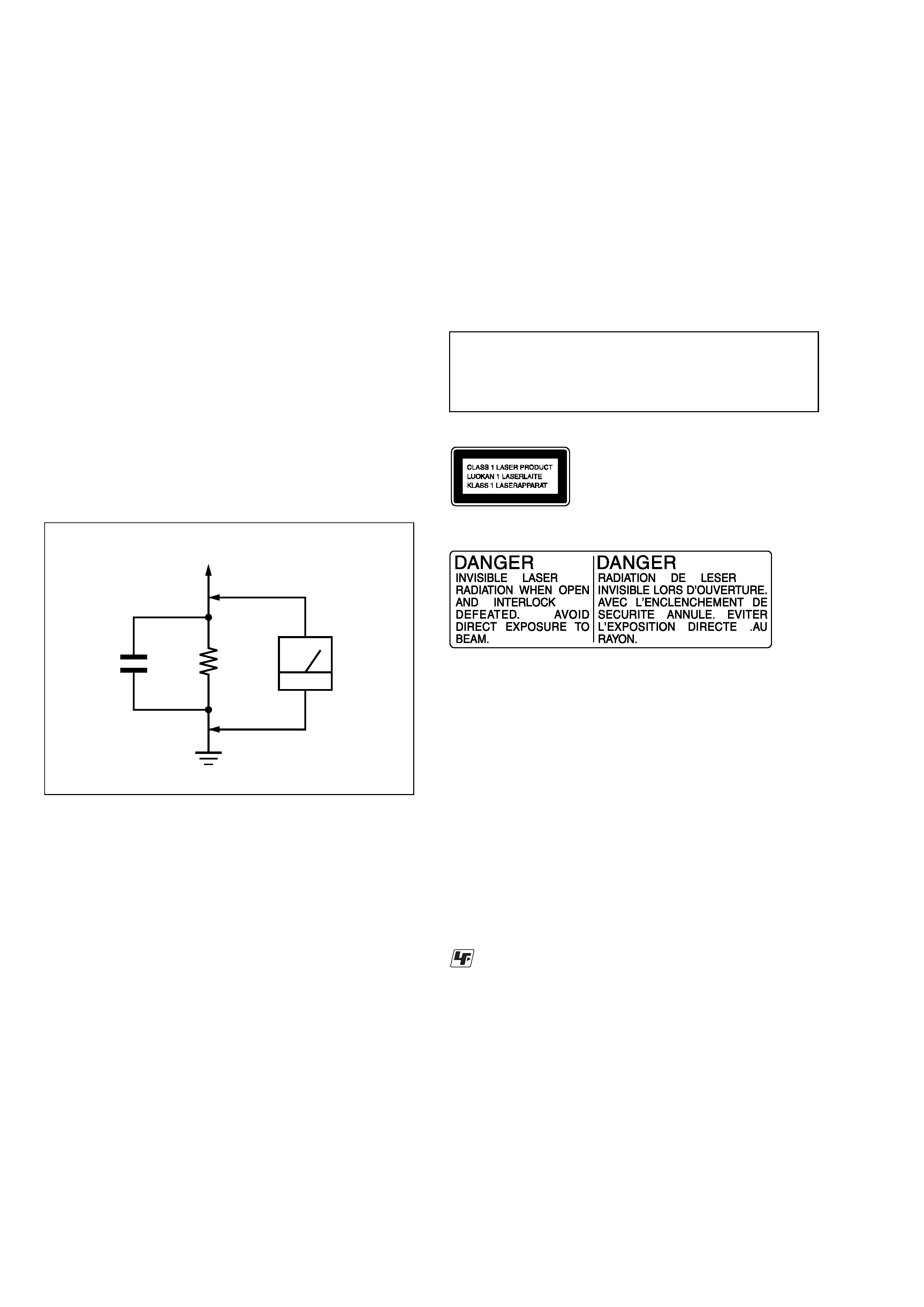
SERVICE MANUAL
Power requirements
North American model:
120 V AC, 60 Hz
European model:
230 V AC, 50/60 Hz
Korean model:
220 V AC, 60 Hz
Australian model:
230
- 240 V AC, 50/60 Hz
Other models:
110
- 120 V or 220 240 V
AC, 50/60 Hz
Adjustable with voltage
selector
Power consumption
CMT-GPX7:
105 W
0.25 W (in Power Saving
Mode)
CMT-GPX6:
80 W
Dimensions (w/h/d)
Approx. 181.5
× 261.5 ×
357.5 mm incl. projecting
parts and controls
Mass
CMT-GPX7:
Approx. 6.3 kg
CMT-GPX6:
Approx. 5.8 kg
Supplied accessories
Remote Commander (1)
R6 (size AA) batteries (2)
AM loop antenna (1)
FM lead antenna (1)
Design and specifications are subject to change
without notice.
Argentina model:
220 V AC, 50 Hz
9-877-741-01
Sony Corporation
2004D05-1
Home Audio Company
© 2004.04
Published by Sony Engineering Corporation
Ver 1.0 2004.04
MICRO Hi-Fi COMPONENT SYSTEM
US Model
Australian Model
CMT-GPX6
AEP Model
CMT-GPX7
E Model
CMT-GPX6/GPX7
· CMT-GPX6/GPX7 are composed of the following models.
As service manuals are issued for each component model, please refer to them.
CMT-GPX6/GPX7
ACCESSORIES
SPECIFICATIONS
COMPONENT MODEL NAME
CMT-GPX6
CMT-GPX7
COMPACT DISC DECK RECEIVER
HCD-GPX6
HCD-GPX7
SPEAKER SYSTEM
SS-CGPX6
SS-CGPX7
1-478-518-11 COMMANDER, STANDARD (RM-SC3)
1-754-102-31 ANTENNA, ROOP (LW.MW)
1-754-243-11 ANTENNA (FM)
4-253-903-12 MANUAL, INSTRUCTION (ENGLISH) (US, SP, HK, AUS, AEP, AR)
4-253-903-21 MANUAL, INSTRUCTION (FRENCH, SPANISH) (SP, AEP, AR)
4-253-903-31 MANUAL, INSTRUCTION (GERMAN, DUTCH, ITALIAN) (AEP)
4-253-903-41 MANUAL, INSTRUCTION (SWEDISH, POLISH) (AEP)
4-253-903-51 MANUAL, INSTRUCTION (TRADITIONAL CHINESE) (SP, HK)
4-253-903-61 MANUAL, INSTRUCTION (KOREAN) (KR)
4-253-903-71 MANUAL, INSTRUCTION (ARABIC) (SP)
4-253-904-11 MANUAL, INSTRUCTION (DANISH, FINNISH) (AEP)
4-253-904-21 MANUAL, INSTRUCTION (PORTUGUESE) (AEP)
4-253-904-31 MANUAL, INSTRUCTION (RUSSIAN) (AEP)
4-253-904-41 MANUAL, INSTRUCTION (GREEK) (AEP)
4-253-904-51 MANUAL, INSTRUCTION (HUNGARIAN, CZECH) (AEP)
4-253-904-61 MANUAL, INSTRUCTION (SLOVAKIAN) (AEP)
4-253-904-71 MANUAL, INSTRUCTION (TURKISH) (AEP)
Part No.
Description
Remark
·Abbreviation
AR
: Argentina model
AUS : Australian model
HK
: Hong Kong model
KR
: Korean model
SP
: Singapore model

2
CMT-GPX6/GPX7
REVISION HISTORY
Clicking the version allows you to jump to the revised page.
Also, clicking the version at the upper right on the revised page allows you to jump to the next revised
page.
Ver.
Date
Description of Revision
1.0
2004.04
New

SERVICE MANUAL
COMPACT DISC DECK RECEIVER
US Model
Australian Model
HCD-GPX6
AEP Model
HCD-GPX7
E Model
HCD-GPX6/GPX7
HCD-GPX6/GPX7
Ver 1.0 2004.04
9-877-742-01
Sony Corporation
2004D05-1
Home Audio Company
© 2004.04
Published by Sony Engineering Corporation
SPECIFICATIONS
HCD-GPX6/GPX7 are the amplifier, CD player,
tape deck and tuner section in CMT-GPX6/GPX7.
Model Name Using Similar Mechanism
NEW
CD
CD Mechanism Type
CDM80B-F1BD81
Section
Base Unit Name
BU-F1BD81A
Optical Pick-up Block Name
KSM-215DCP
Tape deck
Model Name Using Similar Mechanism
NEW
Section
Tape Transport Mechanism Type
CMAL1Z234A
AUDIO POWER SPECIFICATIONS
POWER OUTPUT AND TOTAL HARMONIC DISTORTION:
(The United States model only)
With 6 ohm loads, both channels driven, from
120-10,000 Hz; rated 35 watts per channel minimum
RMS power, with no more than 10% total harmonic
dist ortion from 250 milliwatts to rated output.
Amplifier section
HCD-GPX7
DIN power output (rated): 40 + 40 W (6 ohms at 1 kHz, DIN)
Continuous RMS power output (reference): 60 + 60 W
(6 ohms at 1 kHz, 10% THD)
Music power output (reference): 100 + 100 W
HCD-GPX6
North American model:
Continuous RMS power output (reference): 40 + 40 W
(6 ohms at 1 kHz, 10% THD)
Other models:
The following measured at AC 240 V, AC 220 V or AC 120 V
DIN power output (rated): 30 + 30 W (6 ohms at 1 kHz, DIN)
Continuous RMS power output (reference): 35 + 35 W
(6 ohms at 1 kHz, 10% THD)
Inputs
MD/VIDEO:
Sensitivity 450/250 mV, impedance
47 kilohms
Outputs
PHONES:
Accepts headphones with an
impedance of 8 ohms or more
SPEAKER:
Accepts impedance of 6 to 16 ohms.
CD player section
Laser
Semiconductor laser (
=780 nm)
Emission duration: continuous
Frequency response
20 Hz
- 20 kHz
Wavelength
780
- 790 nm
Tape deck section
Recording system
4-track 2-channel, stereo
Frequency response
50
- 13,000 Hz (±3 dB), using
Sony TYPE I cassettes
Tuner section
FM stereo, FM/AM superheterodyne tuner
FM tuner section
Tuning range
87.5
- 108.0 MHz
Antenna
FM lead antenna
Antenna terminals
75 ohms unbalanced
Intermediate frequency
10.7 MHz
AM tuner section
Tuning range
Pan-American model:
530
- 1,710 kHz
(with the tuning interval set at 10 kHz)
531
- 1,710 kHz
(with the tuning interval set at 9 kHz)
European model:
531
- 1,602 kHz
(with the tuning interval set at 9 kHz)
Other models:
530
- 1,710 kHz
(with the tuning interval set at 10 kHz)
531
- 1,602 kHz
(with the tuning interval set at 9 kHz)
Antenna
AM loop antenna, external
antenna terminal
Intermediate frequency
450 kHz
General
Power requirements
North American model:
120 V AC, 60 Hz
European model:
230 V AC, 50/60 Hz
Korean model:
220 V AC, 60 Hz
Australian model:
230
- 240 V AC, 50/60 Hz
Other models:
110
- 120 V or 220 -240 V
AC, 50/60 Hz
Adjustable with voltage
Power consumption
HCD-GPX7:
105 W
0.25 W (in Power Saving Mode)
HCD-GPX6:
80 W
Dimensions (w/h/d)
Approx. 181.5
× 261.5 × 357.5 mm
incl. projecting parts and controls
Mass
HCD-GPX7:
Approx. 6.3 kg
HCD-GPX6:
Approx. 5.8 kg
Design and specifications are subject to change without notice.
Argentina model:
220 V AC, 50 Hz
Photo: HCD-GPX7

HCD-GPX6/GPX7
2
Notes on chip component replacement
· Never reuse a disconnected chip component.
· Notice that the minus side of a tantalum capacitor may be dam-
aged by heat.
Flexible Circuit Board Repairing
· Keep the temperature of the soldering iron around 270 °C dur-
ing repairing.
· Do not touch the soldering iron on the same conductor of the
circuit board (within 3 times).
· Be careful not to apply force on the conductor when soldering
or unsoldering.
CAUTION
Use of controls or adjustments or performance of procedures
other than those specified herein may result in hazardous ra-
diation exposure.
SAFETY-RELATED COMPONENT WARNING!!
COMPONENTS IDENTIFIED BY MARK 0 OR DOTTED
LINE WITH MARK 0 ON THE SCHEMATIC DIAGRAMS
AND IN THE PARTS LIST ARE CRITICAL TO SAFE
OPERATION. REPLACE THESE COMPONENTS WITH
SONY PARTS WHOSE PART NUMBERS APPEAR AS
SHOWN IN THIS MANUAL OR IN SUPPLEMENTS PUB-
LISHED BY SONY.
This appliance is classified as
a CLASS 1 LASER product.
The CLASS 1 LASER
PRODUCT MARKING is
located on the rear exterior.
UNLEADED SOLDER
Boards requiring use of unleaded solder are printed with the lead-
free mark (LF) indicating the solder contains no lead.
(Caution: Some printed circuit boards may not come printed with
the lead free mark due to their particular size)
: LEAD FREE MARK
Unleaded solder has the following characteristics.
· Unleaded solder melts at a temperature about 40 °C higher than
ordinary solder.
Ordinary soldering irons can be used but the iron tip has to be
applied to the solder joint for a slightly longer time.
Soldering irons using a temperature regulator should be set to
about 350
°C.
Caution: The printed pattern (copper foil) may peel away if the
heated tip is applied for too long, so be careful!
· Strong viscosity
Unleaded solder is more viscou-s (sticky, less prone to flow)
than ordinary solder so use caution not to let solder bridges oc-
cur such as on IC pins, etc.
· Usable with ordinary solder
It is best to use only unleaded solder but unleaded solder may
also be added to ordinary solder.
SAFETY CHECK-OUT
After correcting the original service problem, perform the follow-
ing safety check before releasing the set to the customer:
Check the antenna terminals, metal trim, "metallized" knobs,
screws, and all other exposed metal parts for AC leakage.
Check leakage as described below.
LEAKAGE TEST
The AC leakage from any exposed metal part to earth ground and
from all exposed metal parts to any exposed metal part having a
return to chassis, must not exceed 0.5 mA (500 microamperes.).
Leakage current can be measured by any one of three methods.
1. A commercial leakage tester, such as the Simpson 229 or RCA
WT-540A. Follow the manufacturers' instructions to use these
instruments.
2. A battery-operated AC milliammeter. The Data Precision 245
digital multimeter is suitable for this job.
3. Measuring the voltage drop across a resistor by means of a
VOM or battery-operated AC voltmeter. The "limit" indica-
tion is 0.75 V, so analog meters must have an accurate low-
voltage scale. The Simpson 250 and Sanwa SH-63Trd are ex-
amples of a passive VOM that is suitable. Nearly all battery
operated digital multimeters that have a 2 V AC range are suit-
able. (See Fig. A)
Fig. A.
Using an AC voltmeter to check AC leakage.
1.5 k
0.15
µF
AC
voltmeter
(0.75 V)
To Exposed Metal
Parts on Set
Earth Ground

HCD-GPX6/GPX7
3
TABLE OF CONTENTS
1.
SERVICING NOTES ................................................ 4
2.
GENERAL
Location of Controls .......................................................
6
3.
DISASSEMBLY
3-1. Disassembly Flow ...........................................................
8
3-2. Side Plate (L)/(R) ............................................................
9
3-3. Top Block Assy ...............................................................
9
3-4. Tape Mechanism Deck (CMAL1Z234A) ....................... 10
3-5. Front Panel Section ......................................................... 10
3-6. MAIN Board ................................................................... 11
3-7. CD Mechanism Deck Block ........................................... 11
3-8. Base Unit (BU-F1BD81A) ............................................. 12
3-9. Motor Gear Assy (Sled) (M102), CD Board .................. 12
3-10. Optical Pick-up (KSM-215DCP) .................................... 13
3-11. Chassis (Top) ................................................................... 13
3-12. Lever (Loading-L/R) ....................................................... 14
3-13. Lever (Disc Sensor)/(Disc Stop) ..................................... 15
3-14. Driver Board .................................................................... 15
3-15. Holder (BU215) Assy ..................................................... 16
3-16. Lever (BU Lock) ............................................................. 16
3-17. Close Lever ..................................................................... 17
3-18. (Lever Dir), Gear (IDL-B) .............................................. 17
3-19. Gear (IDL-C) ................................................................... 18
4.
TEST MODE .............................................................. 19
5.
ELECTRICAL ADJUSTMENTS
Deck Section ................................................................... 21
CD Section ...................................................................... 21
6.
DIAGRAMS
6-1. Block Diagram CD SERVO Section ....................... 22
6-2. Block Diagram MAIN Section ................................ 23
6-3. Block Diagram
PANEL/POWER SUPPLY Section .......................... 24
6-4. Note for Printed Wiring Boards and
Schematic Diagrams ....................................................... 25
6-5. Printed Wiring Board CD Board ............................. 26
6-6. Schematic Diagram CD Board ................................ 27
6-7. Printed Wiring Board DRIVER Board .................... 28
6-8. Schematic Diagram DRIVER Board ....................... 29
6-9. Printed Wiring Board MAIN Board ........................ 30
6-10. Schematic Diagram MAIN Board (1/3) .................. 31
6-11. Schematic Diagram MAIN Board (2/3) .................. 32
6-12. Schematic Diagram MAIN Board (3/3) .................. 33
6-13. Printed Wiring Board AMP Board .......................... 34
6-14. Schematic Diagram AMP Board ............................. 35
6-15. Printed Wiring Board PANEL (1) Board ................ 36
6-16. Schematic Diagram PANEL (1) Board ................... 37
6-17. Printed Wiring Board PANEL (2) Board ................ 38
6-18. Schematic Diagram PANEL (2) Board ................... 39
6-19. Printed Wiring Board POWER Board ..................... 40
6-20. Schematic Diagram POWER Board ........................ 41
7.
EXPLODED VIEWS
7-1. Side Plates Section .......................................................... 50
7-2. Front Panel Section ......................................................... 51
7-3. Top Block Section ........................................................... 52
7-4. MAIN Section ................................................................. 53
7-5. Chassis Section ............................................................... 54
7-6. CD Mechanism Deck Section-1 (CDM80B-F1BD81) .. 55
7-7. CD Mechanism Deck Section-2 (CDM80B-F1BD81) .. 56
7-8. CD Mechanism Deck Section-3 (CDM80B-F1BD81) .. 57
7-9. CD Mechanism Deck Section-4 (CDM80B-F1BD81) .. 58
7-10. Base Unit Section (BU-F1BD81A) ................................ 59
8.
ELECTRICAL PARTS LIST ............................... 60
